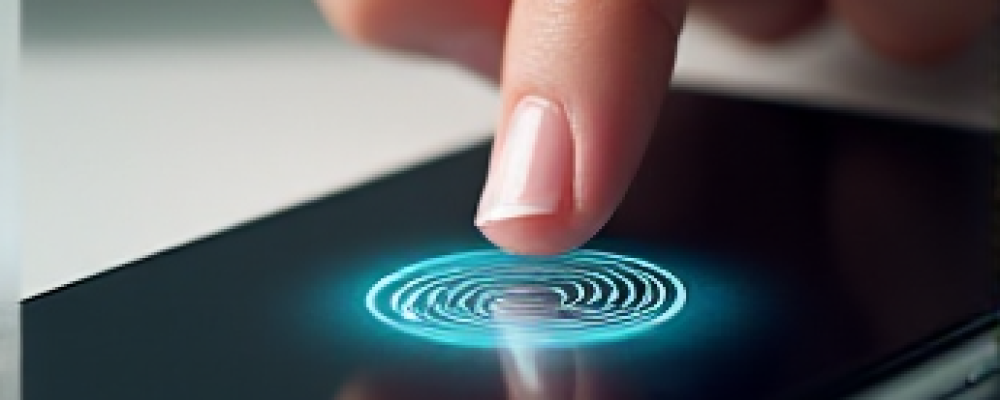Beyond Passwords: Entering the Era of Biometric Authentication
In today’s digitally driven world, securing personal information on our smartphones is paramount. For years, we relied on passwords and PINs, but these methods, while familiar, are often vulnerable. Enter fingerprint scanning, a biometric authentication method that has revolutionized how we unlock our devices and secure sensitive data. This technology has become so ubiquitous that it’s hard to imagine a modern smartphone without it.
The Evolution of Fingerprint Scanning on Phones
The journey of fingerprint scanning on phones wasn’t an overnight success. Early iterations, while innovative, often faced criticism for their reliability and speed. The capacitive fingerprint scanner, the most common type we see today, emerged as the frontrunner. Its core functionality lies in mapping the unique ridges and valleys of your fingerprint.
Capacitive Scanners: How They Work
Imagine a tiny grid of capacitors. When your finger makes contact with the scanner’s surface, the ridges of your fingerprint touch the surface, while the valleys create a small air gap. This difference in contact affects the electrical charge stored in the capacitors. The scanner then reads this pattern of charge variations, creating a digital map of your fingerprint. This map is then compared to the stored fingerprint data to grant or deny access.
Optical Scanners: An Earlier Approach
Before capacitive scanners became mainstream, optical scanners were utilized. These scanners essentially took a digital photograph of your fingerprint. While simpler in concept, they were often less secure and more susceptible to being fooled by high-resolution images of fingerprints.
Ultrasonic Scanners: The Next Generation
A more advanced technology, ultrasonic fingerprint scanners, is now appearing in higher-end devices. These scanners use high-frequency sound waves to create a 3D map of your fingerprint. The sensor emits an ultrasonic pulse that penetrates the skin surface. By measuring the sound waves that are reflected back, the sensor can create a detailed image, including the pores and other unique subsurface features of your fingerprint. This makes them significantly more secure and harder to spoof compared to their optical and even capacitive counterparts.
The Security Landscape: Is Fingerprint Authentication Truly Secure?
Fingerprint scanning offers a significant improvement over traditional password-based security. The uniqueness of fingerprints makes them incredibly difficult to replicate. However, like any technology, it’s not entirely foolproof.
Spoofing Concerns and Countermeasures
Early concerns revolved around the possibility of spoofing
, where fake fingerprints made from materials like silicone could bypass the scanners. However, advancements in sensor technology have made this considerably more difficult. Modern capacitive and ultrasonic scanners incorporate liveness detection
features, which can detect subtle signs of life, such as skin conductivity and blood flow, making it much harder for artificial fingerprints to work.
Data Storage and Privacy
A crucial aspect of fingerprint security is how the fingerprint data is stored. Reputable manufacturers employ secure enclaves, dedicated hardware within the phone’s system-on-a-chip (SoC), to store this sensitive information. This enclave is isolated from the rest of the phone’s operating system, making it incredibly difficult for malicious software to access the fingerprint data. It’s important to note that the actual fingerprint image isn’t stored; instead, a mathematical representation or hash
of the fingerprint is saved, making it virtually impossible to reverse-engineer the original fingerprint.
The Benefits of Using Fingerprint Authentication
The widespread adoption of fingerprint scanners is a testament to their numerous advantages:
- Enhanced Security: Fingerprints are unique and difficult to replicate, offering a stronger layer of security compared to passwords or PINs.
- Convenience: Unlocking your phone or authorizing transactions is as simple as a touch. No need to remember complex passwords.
- Speed: Modern fingerprint scanners are incredibly fast, often unlocking the device in a fraction of a second.
- Integration with Apps and Services: Fingerprint authentication is now widely used for various purposes, including authorizing payments, accessing secure apps, and logging into websites.
Potential Drawbacks and Considerations
While fingerprint scanning offers numerous benefits, there are also some considerations to keep in mind:
- Hygiene: Touching the scanner surface can potentially transfer germs. Regular cleaning of your device is recommended.
- Failure to Recognize: Factors like dry skin, cuts, or dirt on the finger can sometimes hinder the scanner’s ability to recognize the fingerprint.
- Accessibility Concerns: Individuals with certain disabilities might find it challenging to use fingerprint scanners.
The Future of Fingerprint Scanning: Under-Display and Beyond
The evolution of fingerprint scanning continues. A significant advancement is the integration of scanners directly into the phone’s display. These under-display
fingerprint scanners, often utilizing optical or ultrasonic technology, offer a more seamless and aesthetically pleasing design. The technology is still evolving, with manufacturers constantly striving to improve accuracy, speed, and the size of the recognition area.
Looking ahead, we can expect further advancements in biometric authentication. While fingerprint scanning remains a cornerstone, other technologies like facial recognition and iris scanning are also gaining traction. The future likely involves a multi-factor authentication approach, combining various biometric methods for even greater security. This is an area where companies like Unifiers AI are pushing the boundaries, exploring innovative solutions for secure and seamless identity verification.
Conclusion: A Secure and Convenient Authentication Method
Fingerprint scanning has undeniably transformed smartphone security and convenience. From its humble beginnings to the advanced under-display technology we see today, it has become an indispensable feature for millions of users worldwide. While not entirely impervious to vulnerabilities, ongoing advancements in sensor technology and security protocols continue to make it a robust and user-friendly method for protecting our digital lives. As technology progresses, fingerprint scanning will likely remain a key component of the biometric authentication landscape, working in tandem with other methods to create a more secure and seamless user experience.









